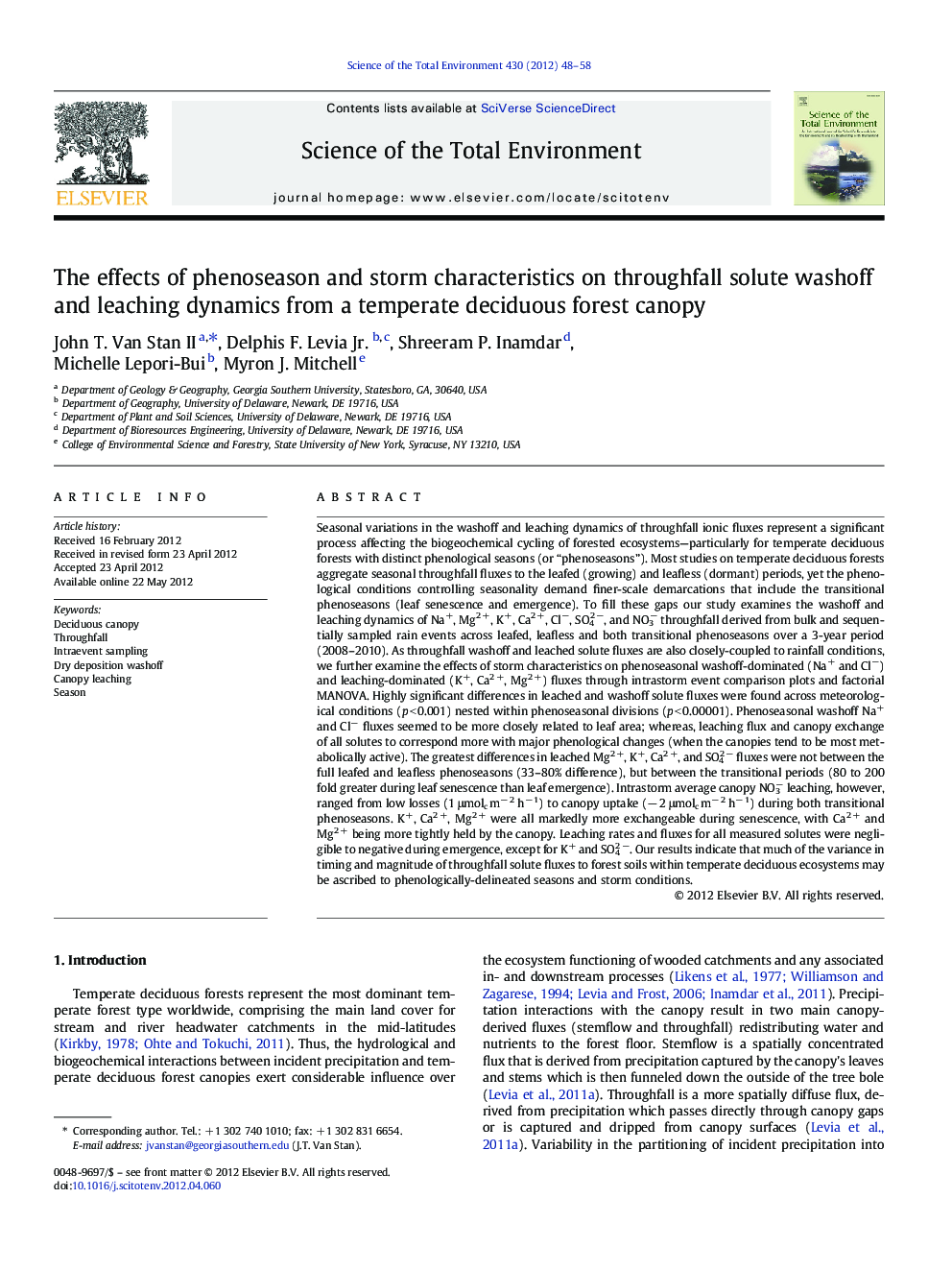| کد مقاله | کد نشریه | سال انتشار | مقاله انگلیسی | نسخه تمام متن |
|---|---|---|---|---|
| 4429349 | 1619822 | 2012 | 11 صفحه PDF | دانلود رایگان |

Seasonal variations in the washoff and leaching dynamics of throughfall ionic fluxes represent a significant process affecting the biogeochemical cycling of forested ecosystems—particularly for temperate deciduous forests with distinct phenological seasons (or “phenoseasons”). Most studies on temperate deciduous forests aggregate seasonal throughfall fluxes to the leafed (growing) and leafless (dormant) periods, yet the phenological conditions controlling seasonality demand finer-scale demarcations that include the transitional phenoseasons (leaf senescence and emergence). To fill these gaps our study examines the washoff and leaching dynamics of Na+, Mg2 +, K+, Ca2 +, Cl−, SO42 −, and NO3− throughfall derived from bulk and sequentially sampled rain events across leafed, leafless and both transitional phenoseasons over a 3-year period (2008–2010). As throughfall washoff and leached solute fluxes are also closely-coupled to rainfall conditions, we further examine the effects of storm characteristics on phenoseasonal washoff-dominated (Na+ and Cl−) and leaching-dominated (K+, Ca2 +, Mg2 +) fluxes through intrastorm event comparison plots and factorial MANOVA. Highly significant differences in leached and washoff solute fluxes were found across meteorological conditions (p < 0.001) nested within phenoseasonal divisions (p < 0.00001). Phenoseasonal washoff Na+ and Cl− fluxes seemed to be more closely related to leaf area; whereas, leaching flux and canopy exchange of all solutes to correspond more with major phenological changes (when the canopies tend to be most metabolically active). The greatest differences in leached Mg2 +, K+, Ca2 +, and SO42 − fluxes were not between the full leafed and leafless phenoseasons (33–80% difference), but between the transitional periods (80 to 200 fold greater during leaf senescence than leaf emergence). Intrastorm average canopy NO3− leaching, however, ranged from low losses (1 μmolc m− 2 h− 1) to canopy uptake (− 2 μmolc m− 2 h− 1) during both transitional phenoseasons. K+, Ca2 +, Mg2 + were all markedly more exchangeable during senescence, with Ca2 + and Mg2 + being more tightly held by the canopy. Leaching rates and fluxes for all measured solutes were negligible to negative during emergence, except for K+ and SO42 −. Our results indicate that much of the variance in timing and magnitude of throughfall solute fluxes to forest soils within temperate deciduous ecosystems may be ascribed to phenologically-delineated seasons and storm conditions.
► Details effect of phenoseason on intrastorm throughfall leaching and washoff dynamics
► Evaluates effect of phenoseason–storm condition interactions on throughfall flux
► Examines phenoseasonal/storm condition effects on timing of throughfall soil inputs
► First to apply/evaluate Kazda (1990) integration method to intrastorm throughfall data
Journal: Science of The Total Environment - Volume 430, 15 July 2012, Pages 48–58